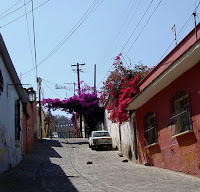What Not to Paint
Finding the essential elements of your image
Since so many of us tend to put more information in our pictures than we intend, we will concentrate for a while on ways to distinguish the essential from the optional. Here are two potential approaches to sorting out what has to be there in the finished painting and what does not. They can all be thought of as deliberate over-simplifications of the image:
1) If the image or scene has a pronounced dark/light pattern, try just painting the darks as a collection of black shapes, and leaving out everything else. The result should reveal how much of the job of telling the story is done by the darks. If the narrative content is clear, then you know you can be casual with the initial light and middle value layers.
2) Make a version of the scene in which the major shapes are simplified almost to pure geometric shapes, eliminating subtlety of outline. Treat each shape as a flat wash, with no texture at all. When you assess the result, look for the places that really need more subtlety or specificity, and take note of any places where what you thought was too little information turned out to be enough.
Both approaches can help you see at what stages of the painting you can be carefree, and when you will need to be careful. Write down what you discover, and have fun.




No comments:
Post a Comment